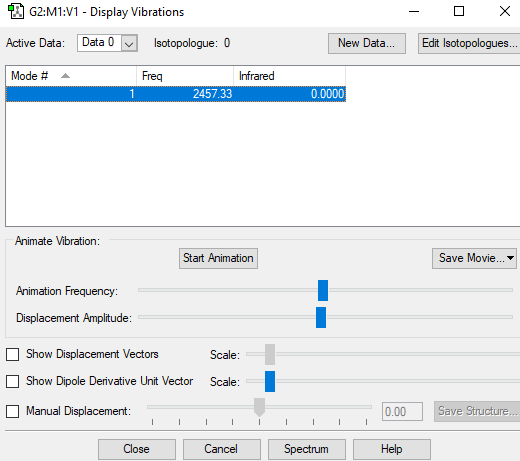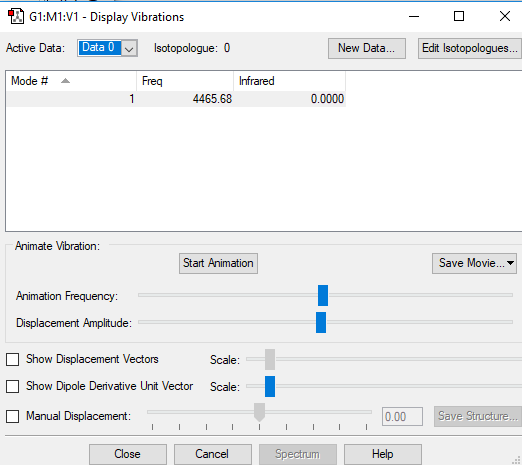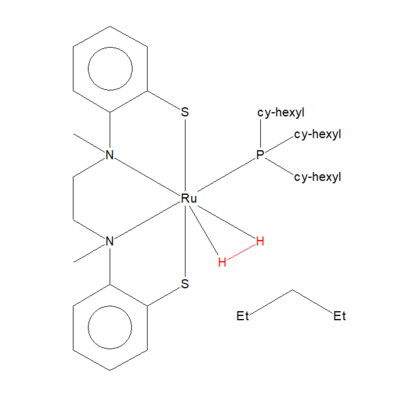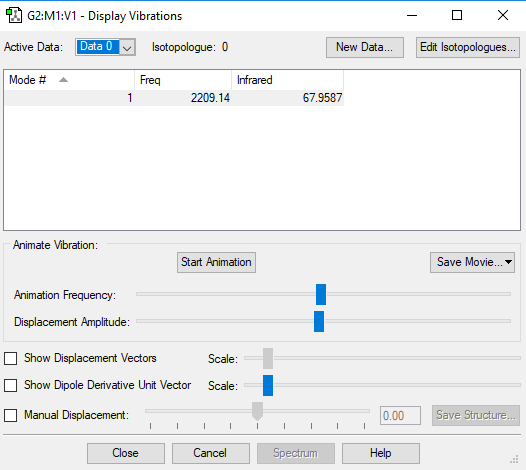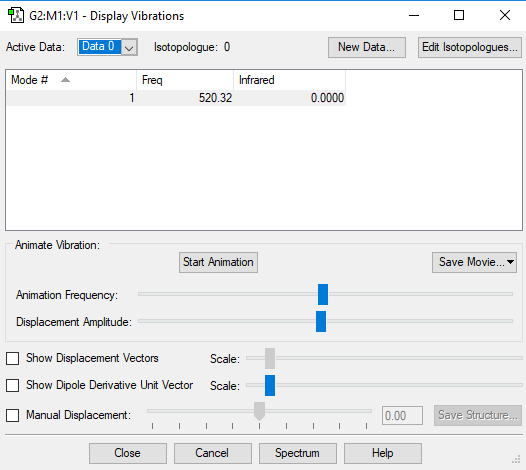Rep:Title=Mod:AT6318
NH3
Summary of molecule
Molecular Name: Ammonia
Method: B3LYP
Basis Set: 6- 31G (d,p)
Point Group: C3v
Final Energy:-56.55776873 a.u.
RMS Gradient:0.00000485 a.u.
Item Value Threshold Converged? Maximum Force 0.000004 0.000450 YES RMS Force 0.000004 0.000300 YES Maximum Displacement 0.000072 0.001800 YES RMS Displacement 0.000035 0.001200 YES
Ammonia Molecule |
The optimisation file is linked to File:AT6318 NH3 OPTF POP.LOG
Molecular Dimensions
N-H Bond Length= 1.02Å +/- 0.01Å
H-N-H Bond Angle= 106° +/- ≈ 1°
Molecular Vibrations
From the 3N-6 rule there are 6 modes expected as N=4. Both the 1694cm-1) and the 3590cm-1) modes are degenerate. The mode that is highly symmetric has the wavenumber of 3461cm-1), and the 1090cm-1) mode is known as the umbrella mode. Therefore on an experimental spectrum of ammonia only 2 bands are expected to be shown as the 3590cm-1) modes have intensities very close to zero and there are only two pairs of degenerate vibrations.
Charge Distribution
Charge on Nitrogen=-1.125
Charge on Hydrogen=0.375
The charge on the nitrogen is negative and on hydrogen is positive this is to be expected as nitrogen has a higher electronegativity than hydrogen.
N2
Summary of molecule
Molecular Name: Nitrogen
Method: RB3LYP
Basis Set: 6- 31G (d,p)
Point Group: D∞h
Final Energy:-109.52412868 a.u.
RMS Gradient:0.00000060 a.u.
Item Value Threshold Converged? Maximum Force 0.000001 0.000450 YES RMS Force 0.000001 0.000300 YES Maximum Displacement 0.000000 0.001800 YES RMS Displacement 0.000000 0.001200 YES
Nitrogen Molecule |
The optimisation file is linked to File:AT6318 N2 OPTF POP2.LOG
Molecular Dimensions
N≡N Bond Length= 1.09Å +/- 0.01Å
N≡N Bond Angle= N/A
Molecular Vibrations
| Wavenumber (cm-1) | 2457 |
| Symmetry | SGG |
| Intensity (a.u) | 0 |
| Image | 
|
| Type of Vibration | Stretching |
Charge Distribution
Charge on Nitrogen=0
Both atoms in the molecule are nitrogen so the electrons in their bond are equally shared so therefore have no resultant charge.
H2
Summary of molecule
Molecular Name: Hydrogen
Method: RB3LYP
Basis Set: 6- 31G(D,P)
Point Group: D∞h
Final Energy: -1.17853936a.u.
RMS Gradient: 0.00000017a.u.
Item Value Threshold Converged? Maximum Force 0.000000 0.000450 YES RMS Force 0.000000 0.000300 YES Maximum Displacement 0.000000 0.001800 YES RMS Displacement 0.000001 0.001200 YES
Hydrogen Molecule |
The optimisation file is linked to File:AT6318 H2 OPTF POP.LOG
Molecular Dimensions
H-H Bond Length= 0.74Å +/- 0.01Å
H-H Bond Angle= N/A
Molecular Vibrations
| Wavenumber (cm-1) | 4466 |
| Symmetry | SGG |
| Intensity (a.u) | 0 |
| Image | 
|
| Type of Vibration | Stretching |
Charge Distribution
Charge on Hydrogen=0
Both atoms in the molecule are Hydrogen so the electrons in their bond are equally shared so therefore have no resultant charge.
Mono-Metallic TM Complex Coordinating H2
The molecule is linked to this page [1]
This mono-metallic TM complex coordinates H2. It's molecular name is (Dihydrogen)-(1,2-ethanediamine-N,N'-dimethyl-N,N'-bis(2-benzenethiolato))-(tricyclohexylphosphine)-ruthenium pentane solvate and it's unique identifier is BIDROW. The bond distance of H-H in the crystalline structure is 1.00Å (2dp) whereas the computation distance is 0.74Å therefore the bond distance in the crystalline structure is longer this could be because the Hydrogens are bonded to the Ru atom which is a transition metal and pulls electron density away from the H-H bond decreasing its bond strength and therefore lengthening it. The difference in bond lengths could also be down to the computational molecular optimisation which can differ from experimental values. Furthermore the bond distance of H-H bond measured through computational methods is of a gaseous molecule whereas H2 is in a solid state in the crystalline structure.
Haber-Bosch process
N2+ 3H2 → 2NH3
E(NH3)= -56.55776873 a.u.
2*E(NH3)= -113.1155375 a.u.
E(N2)= -109.52412868 a.u.
E(H2)= -1.17853936 a.u.
3*E(H2)= -3.53561808 a.u.
ΔE=2*E(NH3)-[E(N2)+3*E(H2)]= -0.05579074 a.u.
ΔE=-146.8 kJmol-1
Therefore the ammonia product is more stable than the gaseous reactants as the forward reaction is exothermic as the energy for converting the hydrogen and nitrogen gas into ammonia gas is negative.
CO
Summary of molecule
Molecular Name: Carbon Monoxide
Method: RB3LYP
Basis Set: 6-31G(d,p)
Point Group: C∞V
Final Energy: -113.30945314 a.u.
RMS Gradient:0.00001828a.u.
Item Value Threshold Converged? Maximum Force 0.000032 0.000450 YES RMS Force 0.000032 0.000300 YES Maximum Displacement 0.000012 0.001800 YES RMS Displacement 0.000018 0.001200 YES
Carbon Monoxide Molecule |
The optimisation file is linked to File:CARBONMONOXIDEOPTIMISATIONAT6318.LOG
Molecular Dimensions
C≡O Bond Length 1.14Å +/- 0.01Å
Bond Angle=N/A
Molecular Vibrations
| Wavenumber (cm-1) | 2209 |
| Symmetry | SG |
| Intensity (a.u) | 68 |
| Image | 
|
| Type of Vibration | Stretching |
Charge Distribution
Charge on Carbon=0.506
Charge on Oxygen=-0.506
This is because oxygen is more electronegative than carbon.
Molecular Orbitals
Cl2
Summary of molecule
Molecular Name: Chlorine
Method: RB3LYP
Basis Set: 6- 31G (d,p)
Point Group: D∞H
Final Energy:-920.34987886 a.u.
RMS Gradient:0.00002510 a.u.
Item Value Threshold Converged? Maximum Force 0.000043 0.000450 YES RMS Force 0.000043 0.000300 YES Maximum Displacement 0.000121 0.001800 YES RMS Displacement 0.000172 0.001200 YES
Chlorine Molecule |
The optimisation file is linked to File:AT6318CL2OPTIMISATION.LOG
Molecular Dimensions
Cl-Cl Bond Length 2.04Å +/- 0.01Å
Bond Angle=N/A
Molecular Vibrations
| Wavenumber (cm-1) | 520 |
| Symmetry | SGG |
| Intensity (a.u) | 0 |
| Image | 
|
| Type of Vibration | Stretching |
Charge Distribution
Charge on Chlorine=0
Both atoms in the molecule are Chlorine so the electrons in their bond are equally shared so therefore have no resultant charge.
Marking
Note: All grades and comments are provisional and subject to change until your grades are officially returned via blackboard. Please do not contact anyone about anything to do with the marking of this lab until you have received your grade from blackboard.
Wiki structure and presentation 1/1
Is your wiki page clear and easy to follow, with consistent formatting?
YES
Do you effectively use tables, figures and subheadings to communicate your work?
YES
NH3 1/1
Have you completed the calculation and given a link to the file?
YES
Have you included summary and item tables in your wiki?
YES
Have you included a 3d jmol file or an image of the finished structure?
YES
Have you included the bond lengths and angles asked for?
YES
Have you included the “display vibrations” table?
YES
Have you added a table to your wiki listing the wavenumber and intensity of each vibration?
YES
Did you do the optional extra of adding images of the vibrations?
YES
Have you included answers to the questions about vibrations and charges in the lab script?
YES
N2 and H2 0.5/0.5
Have you completed the calculations and included all relevant information? (summary, item table, structural information, jmol image, vibrations and charges)
YES
Crystal structure comparison 0.5/0.5
Have you included a link to a structure from the CCDC that includes a coordinated N2 or H2 molecule?
YES
Have you compared your optimised bond distance to the crystal structure bond distance?
YES
Haber-Bosch reaction energy calculation 1/1
Have you correctly calculated the energies asked for? ΔE=2*E(NH3)-[E(N2)+3*E(H2)]
YES
Have you reported your answers to the correct number of decimal places?
YES
Do your energies have the correct +/- sign?
YES
Have you answered the question, Identify which is more stable the gaseous reactants or the ammonia product?
YES
Your choice of small molecule 3/5
Have you completed the calculation and included all relevant information?
YES
Have you added information about MOs and charges on atoms?
YES
You could have explained the calculated vibrational mode. You could have been more specific regarding the contributing AOs. (eg. 2pz instead of 2p) You could have explained the energies of the MOs. The first two MOs are each based on one 1s orbital only. Mo1 is based on the O 1s and MO2 on C 1s. The first two MOs are non-bonding as there is no overlap with another AO. For MOs 4 and 5 you only state they are involved in bonding but you are not explaining in which way.
Independence 1/1
If you have finished everything else and have spare time in the lab you could:
Check one of your results against the literature, or
Do an extra calculation on another small molecule, or
YES
Do some deeper analysis on your results so far








